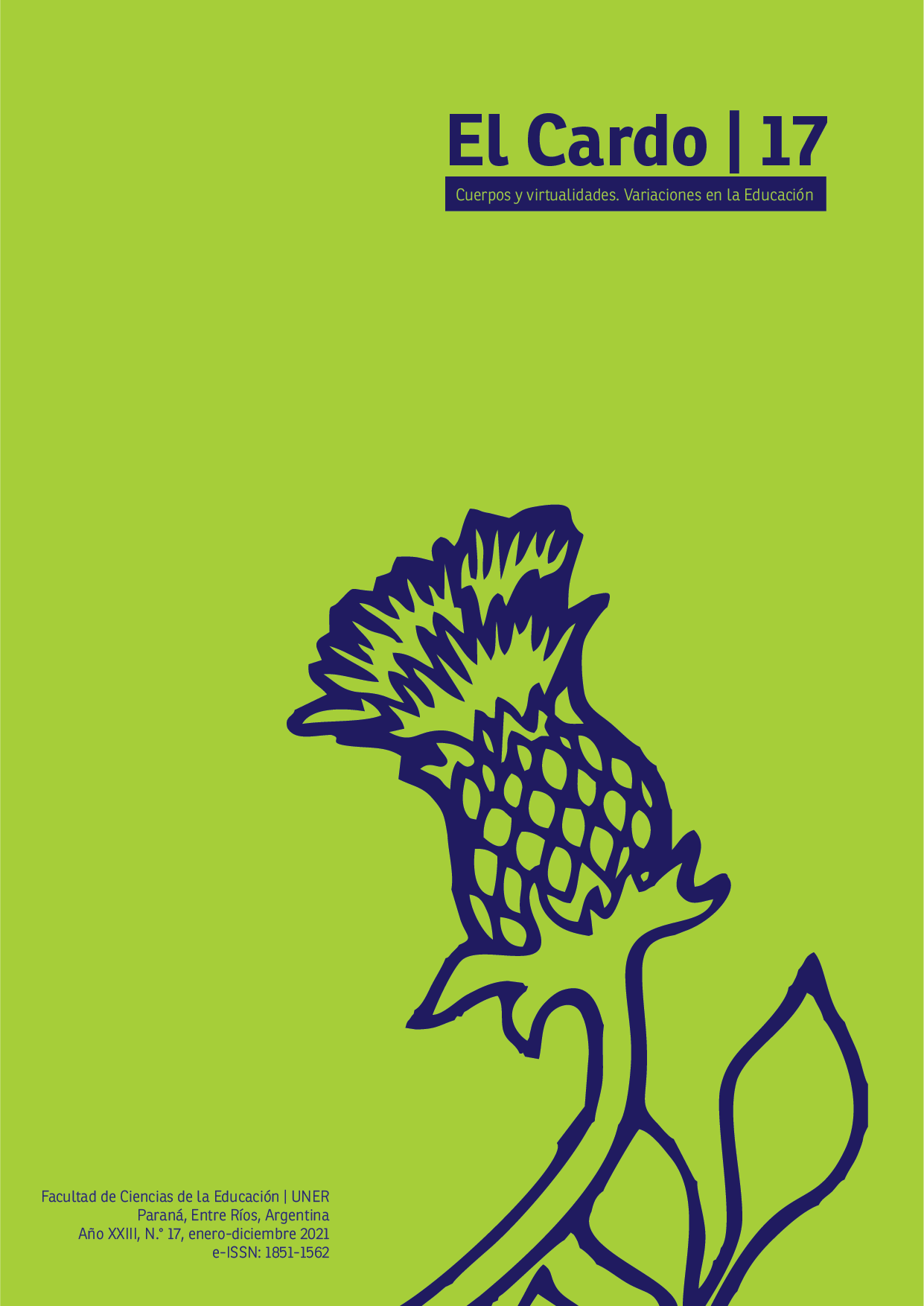Enseñar y aprender en la virtualidad: un relato autoetnográfico sobre el lugar del cuerpo en los nuevos escenarios educativos
Contenido principal del artículo
Resumen
Los docentes y estudiantes construimos modos de hacer y de ver propios al ir transitando la universidad. En este sentido, habitamos estas prácticas, que se caracterizan por los tiempos y espacios poblados de discursos, objetos, fantasmas, miradas, ilusiones y materialidades singulares. Nuestros cuerpos conforman dicha materialidad. Su presencia es ineludible, pues existimos porque somos cuerpos. Es en ellos donde dejan huellas nuestras experiencias.
Debido a la pandemia por COVID-19, durante el último año, inserta en un contexto de aislamiento y distanciamiento social obligatorio, nuestra universidad tuvo que convertir sus actividades presenciales en virtuales. Surgieron escenas impensadas en las que nuestras prácticas se vieron alteradas, así como el lugar de nuestros cuerpos en ellas. Nos reinventamos, ya que la incertidumbre y la imprevisibilidad fueron extremas. Produjimos nuevos sentidos sobre el enseñar y aprender, experimentamos un extrañamiento de las maneras que teníamos de hacerlo antes, en la presencialidad, en contraste con lo que la situación virtual nos reclamaba que hiciésemos.
En este escrito presento, desde un enfoque de investigación y una metodología especifica como lo es la autoetnografía, un relato acerca del lugar del cuerpo en las nuevas escenas virtuales del enseñar y aprender en la universidad.
Los objetivos de este trabajo son comprender el lugar que ocupa el cuerpo en la escena educativa virtual e invitar al lector a reflexionar acerca de la propia experiencia de la corporalidad en situaciones de enseñanza y aprendizaje universitario en general y en la virtualidad en especial.
Fecha de recepción: 25/2/2021
Fecha de aceptación: 25/5/2021
Descargas
Detalles del artículo

Esta obra está bajo una licencia internacional Creative Commons Atribución-NoComercial-CompartirIgual 4.0.
Las ediciones no tienen cargos para las y los autores ni para las y los lectores, y se incita a las y los autores a depositar sus contribuciones en otros repositorios institucionales y temáticos, con la certeza de que la cultura y el conocimiento son un bien de todos y para todos. El Cardo permite la reutilización luego de su edición (Post print) citando la autoría y la fuente original de su publicación. Su uso no puede ser con fines comerciales.
Citas
BERENSTEIN, I. (2008). Del ser al hacer. Buenos Aires: Paidós.
BYUNG-CHUL, H (2013). La Sociedad de la transparencia. España: Herder.
CHANG, H. (2008). Autoethnography as method. USA: Left Coast Press,Inc.
CHANG, H., NGUNJIRI, F. W., HERNANDEZ, K. C. (2013). Collaborative autoethnography. USA: Left Coast Press.
DENZIN, N. (2013) [En línea] Autoetnografía analítica o nuevo déjà vu. Traducción Aldo Merlino y Alejandra Martínez. Astrolabio. Número 11, 2013 (207-220). [Consulta: 21 de octubre de 2015]. Disponible en: https://revistas.psi.unc.edu.ar/index.php/astrolabio/article/view/6310/7398
ELLIS, C. (2004). The Ethnographic I. USA: AltaMira Press.
ELLIS, C.; ADAMS, T. Y BOCHNER, A. (2011) Autoethnography: An
Overview. Forum Qualitative Sozialforschung / Forum: Qualitative Social Research, 12(1), Art.10, [Consulta: 3 de setiembre de 2016]. Disponible en: http://nbn-resolving.de/urn:nbn:de:0114-fqs1101108.
ELLIS, C. Y BOCHNER, A. (2006) «Analyzing Analytic Autoethnography: An Autopsy». [Consulta: 10 de diciembre de 2010]. Disponible en: Journal of Contemporary Ethnography 2006; 35; 429 – 449.
GERGEN, K. (2009). An invitation to social construction. California: Sage.
HOLMAN JONES, S. (2021). Workshop: Theory and Story: Autotheory, Autoethnography and Other Forms of Bringing Together the Personal and the Theoretical. Notas del taller realizado en el marco del International Symposium on Autoethnography and Narrative (ISAN). Enero 2021.
HOLMAN JONES, S. (2016). Living Bodies of Thought: The «Critical» in Critical Autoethnography. Qualitative Inquiry, 22(4), 228–237.
DOMÍNGUEZ FIGAREDO, D. (2012). Escenarios híbridos, narrativas transmedia, etnografía expandida. En: Revista de Antropología Social. 21.Pp 197-215. [Consulta: 9 de octubre de 2020]. Disponible en: https://ssrn.com/abstract=2811769
DUCH, L Y MELICH, J. C. (2005). Escenarios de la corporalidad. Madrid: Editorial Trotta.
JASINER, G. (2020). La trama de los grupos. Buenos Aires: Lugar editorial.
KEMMIS, S. (2010). What is professional practice? Recognizing and respecting diversity in understandings of practice. En: CLIVE K. (ed.) Elaborating professionalism: Studies in practice and theory. New York: Springer.
LÓPEZ GABRIELIDIS, M. (2015). Régimen de visibilidad y vigilancia en la era de la Identidad Digital. Teknokultura. En: Revista De Cultura Digital Y Movimientos Sociales, 12(3), 473-499. [Consulta: 10 de noviembre de 2020]. Disponible en: https://doi.org/10.5209/rev_TK.2015.v12.n3.50385
MAZZA, D. (2014). El sentido de la enseñanza (Partes I y II). En: Revista Noticias, Editorial Perfil. 6 y 13 de diciembre. Argentina.
---------------- (2020). Lo que la pandemia nos deja: una oportunidad para pensarnos como docentes. Buenos Aires. Centro de Innovación en Tecnología y Pedagogía. Secretaría de Asuntos Académicos. UBA. [Consulta: 17 de mayo de 2021]. Disponible en: http://citep.rec.uba.ar/wp-content/uploads/2020/05/AcaDocs_D07_Lo-que-la-pandemia-nos-deja-1.pdf
MERLEAU-PONTY, M. (1964). El hombre y la adversidad. En: Signos, trad. Caridad Martinez y Gabriel Oliver, Barcelona: Seix Barral, 283-304.
NANCY, J.L. (2007). 58 indicios sobre el cuerpo. Extensión del alma. Buenos Aires: Ediciones La Cebra.
NASIO, J.D. (2008). Mi cuerpo y sus imágenes. Buenos Aires: Paidós.
ROA BASTOS, A. (1996). Metaforismos. Buenos Aires: Seix Barral.
SCHATZKI, T. (2001) Introduction: practice theory. En: SCHATZKI, T. KNORR CETINA, K. y VON SAVIGNY, E. (editors). The practice turn in Contemporary Theory. London: Routledge, 10-23.
-------------- (2012). A primer on Practices: Theory and Research». In Hutchings, M. and Trede, F. (editor.) Practice. Based Education: Perspectives and Strategies. Rotterdam: Sense Publishers, 13-26.
SOUTO, M. (1996). La clase escolar. Una mirada desde la didáctica de lo grupal. En: CAMILLONI, A., DAVINI, M., EDELSTEIN, G., LITWIN, E., SOUTO, M. y BARCO, S. Corrientes didácticas contemporáneas. Buenos Aires: Paidós.

